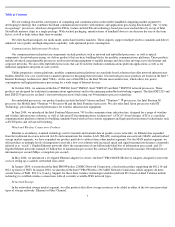Intel 2004 Annual Report Download - page 17
Download and view the complete annual report
Please find page 17 of the 2004 Intel annual report below. You can navigate through the pages in the report by either clicking on the pages listed below, or by using the keyword search tool below to find specific information within the annual report.
Table of Contents
Intel Communications Group
Within ICG, we are focused on developing component-level products for the wireless handheld computing and communications market
segments. We also are developing products that we believe will help continue to build out the Internet.
Component-level products for the wireless handheld computing and communications market segments include flash memory products,
application processors and cellular baseband chipsets. In our various market segments, our products currently compete with the products of
other companies, such as QUALCOMM, Samsung Electronics Co., Ltd., Spansion LLC (a subsidiary of AMD), STMicroelectronics NV and
Texas Instruments Incorporated. The megabit demand of the products that make use of flash memory is increasing, and our NOR flash memory
products face increased competition from companies that manufacture NAND flash memory products, as OEMs look for opportunities to use
NAND flash memory products with additional random access memory or in combination with NOR flash memory for executable
-code
applications. Various digital cellular technologies are used throughout the cellular communications industry, including but not limited to GSM
(Global System for Mobile Communications), GPRS (General Packet Radio Service), CDMA (Code Division Multiple Access) and WCDMA
(Wideband CDMA). Our ability to compete successfully with our cellular baseband chipsets is dependent on having products available for the
most prevalent or widely adopted digital cellular technology. Our current product offerings are for use in cell phones and PDAs that incorporate
the GSM/GPRS cellular technologies. Our products planned for release in 2005 will be targeted for the WCDMA as well as GSM/GPRS
cellular technologies.
In support of the build-out of the Internet, we offer products designed for wired and wireless connectivity; for the communications
infrastructure, including network and embedded processors; and for networked storage. In these areas, we face competition from both
established and emerging companies. Our products currently compete against offerings from companies such as Applied Micro Circuits
Corporation, Atheros Communications, Broadcom, Freescale Semiconductor, Inc., IBM, Marvell Technology Group Ltd. and Texas
Instruments. We cannot predict whether our networking and communications products will continue to compete successfully with those of our
existing competitors or new market entrants.
Acquisitions and Strategic Investments
Our level of new acquisition and strategic investment activity for 2004 and 2003 was substantially lower than in prior years. During 2004,
we completed one acquisition for net cash consideration of approximately $33 million, plus certain liabilities. In addition, we entered into
certain arrangements in 2004 related to the hiring of a group of employees that resulted in the recording of workforce-in-
place of $28 million in
other acquisition-related intangibles within other assets on our balance sheet.
Under our Intel Capital program, we make equity investments in companies around the world to further our strategic objectives and
support our key business initiatives. The Intel Capital program generally focuses on investing in companies and initiatives to stimulate growth
in the digital economy, create new business opportunities for Intel and expand global markets for our products. The investments may support,
among other things, Intel product initiatives, emerging trends in the technology industry or worldwide Internet deployment. This strategic
investment program helps advance our overall mission to be the preeminent supplier of building blocks to the worldwide digital economy.
Many of our investments are in private companies, including development-stage companies with little or no revenue from current product
offerings.
We invest in companies that develop software, hardware or services supporting our technologies. Our current investment focus areas
include enabling mobile wireless devices, helping to advance the digital home, enhancing the digital enterprise, advancing high-performance
communications infrastructures and developing the next generation of silicon production technologies. Our focus areas tend to develop and
change over time due to rapid advancements in technology.
Intellectual Property and Licensing
Intellectual property rights that apply to our various products and services include patents, copyrights, trade secrets, trademarks and
maskwork rights. We maintain an active program to protect our investment in technology by attempting to ensure respect for our intellectual
property rights. The extent of the legal protection given to different types of intellectual property rights varies under different countries’ legal
systems. We intend to license our intellectual property rights where we can obtain adequate consideration. See “Competition” in Part I, Item 1
of this Form 10-K.
14
























